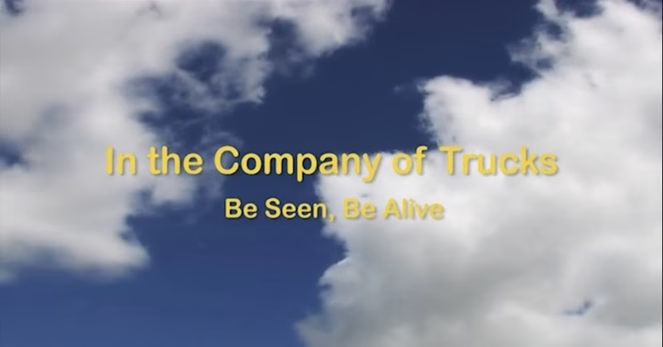Be Seen, Be Alive: Revisiting a Log Truck Safety Message That Still Matters

June is National Safety Month, as designated by the National Safety Council. As we reach the halfway point of the month—and as more people hit the highways for summer vacations—it’s a timely moment to highlight roadway safety.
Back in 2012, the North Carolina Association of Professional Loggers (now the Carolina Loggers Association) and the NC Agromedicine Institute identified the need to better educate the public on safely sharing the roadways with large commercial trucks. With funding from the Timber Harvesting & Transportation Safety (THATS) Foundation, they produced a 10-minute safety video, In the Company of Trucks: Be Seen, Be Alive. While the video may appear a bit dated today, its core message remains timeless. The entire 10-minute video is available here.
Several safety concepts are reinforced in the video, but two stood out then—and still stand out now:
- Understanding truck blind spots or “No-Zones” and the importance of safe passing
- Recognizing a truck’s need to make extra wide right turns
These concepts are often covered in driver’s education, along with the need for greater stopping distances for larger, heavy-load vehicles. They’re not just essential for new drivers—they’re good reminders for all of us, no matter how long we’ve been behind the wheel.
Another issue raised in the video—one that’s even more relevant today—is distracted driving. While hands-free technology and Bluetooth have helped reduce some distractions, the temptation to multitask behind the wheel persists. If anything, the risk has grown.
The video features Kevin Tutor, a professional truck driver and son of Dr. Robin Tutor Marcom, a respected safety advocate and retired director of the NC Agromedicine Institute. Kevin has roughly 20 years of experience transporting roundwood and other agricultural commodities throughout Eastern North Carolina. He currently drives for Andrews Brothers Trucking in Trenton, NC, operated by Garrett and Tyler Andrews—who also manage logging crews for their father’s company, Anthony B. Andrews Logging (FRA’s 2014 National Outstanding Logger Award winner).
I rewatched the video last week and couldn’t help but wonder—what does Kevin think about it now, more than a decade later? Is it still relevant? Would he change anything? Essentially, a little Monday Morning Quarterbacking on the relevance of the video in 2025.
So, I reached out and had the chance to interview Kevin, and we covered a lot of ground: near misses that are seared in his memory, the pride he takes in driving a “nice” well-maintained truck, and even our shared experiences raising teenage drivers.
One part of the conversation stuck with me—Kevin’s thoughts on dash cameras. He’s been using one for three years now, but he admits it took some getting used to:
“I was a little iffy at first,” he said.
Experiencing a near miss approximately three years ago and having documented proof that he was at no fault solidified his position on dash camera use and whether he would operate a truck without one.
“I’d rather not [drive without one]!”
We also discussed the importance of steel-reinforced, trailer-mounted headache racks. According to Kevin, a properly fabricated version can be a lifesaver.
“Hands down, if built properly!”
But one of the biggest shifts since the video’s release? Kevin and I agree—it’s the growing volume of traffic on the roads. Urban sprawl, population growth, and infrastructure that wasn’t designed for current traffic levels have all contributed to more congestion—and more risk.
These concerns are backed by research. A recent FRA-funded study by Dr. Joe Conrad of the University of Georgia found that population growth is a contributing factor to the rise in crash rates across the Southeastern U.S. You can find more in the Technical Release, “Do Higher Weight Limits Raise Log Truck Crash Risk? (21-R-22).”
Kevin also highlighted another key change:
“Phones are much bigger now and used for more than talking. I’ve seen drivers watching movies and posting on TikTok. If you think they were a problem then [in 2012], they’re really a problem now!”
He also noted an uptick in road rage. He recounted one recent experience where he had to take evasive action as three vehicles locked in a road rage incident nearly caused a multi-car collision—culminating in a fistfight on the exit ramp to the mill.
More traffic, more intersections, more traffic lights, more traffic circles, and more diverging diamond interchanges (my favorite!)—it all adds up to more chances for things to go wrong.
Recognizing the need for new research and resources, the NC Agromedicine Institute launched a study in 2023—sponsored by the Central Appalachian Regional Education and Research Center (University of Kentucky)—to better understand how to teach teen drivers about sharing the road with large trucks. The study had two objectives:
- Identify gaps in North Carolina’s driver education curriculum related to logging trucks and other agricultural vehicles.
- Examine the effectiveness of the existing educational video, In the Company of Trucks, as an intervention strategy for rural and suburban youth.
The recent FRA Technical Release, “Youth-Engaged Research to Promote Driving Safely in the Company of North Carolina Log Trucks (25-TR-06),” brought the video back to the attention of forest products transportation stakeholders and promoted the video as an effective training tool for inexperienced teen drivers.
The study concluded that early, targeted interventions can help young drivers develop better attitudes toward roadway safety. It also identified a clear gap: many instructors aren’t aware of resources like this video—and driver education materials need to do more to address log truck safety.
Yes, the vehicles and phones shown in the video are outdated. The statistics have changed. But the message? It still matters. Videos like this one are still powerful tools—especially for young drivers just learning the rules of the road.
So, here’s to Kevin Tutor—and to the many professional drivers like him who work hard every day to keep our roads safe while playing a critical role in the wood supply chain. And if you’ve got a teen driver in your life, take the opportunity to talk to them about safely sharing the road with trucks. There’s no better time than now to pass that message along.

